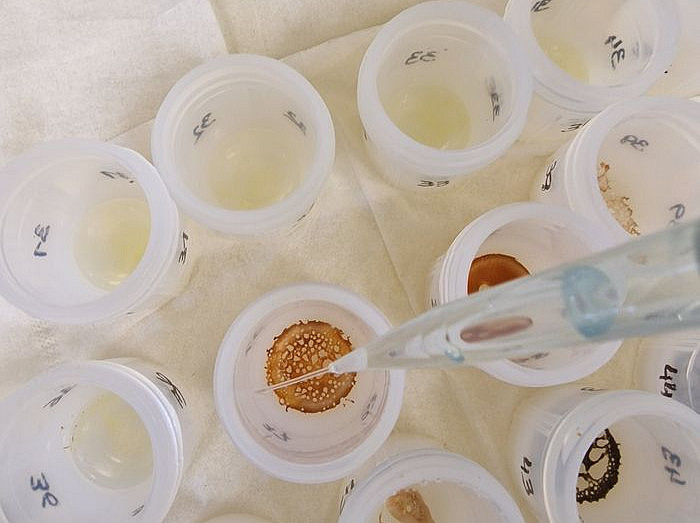
The low concentrations of the elements in the trace and ultra-trace analysis pose the problem of possible contamination. For this reason, the samples for these analyses are processed in a clean room laboratory specially built for this purpose. This primarily includes wet digestion and, subsequently, element separation for isotope analysis.
As a rule, the samples are available as finely ground powder. During wet digestion, these solid samples are transferred into solutions so that the elemental composition of the sample can be analyzed using mass spectrometry.
In most cases, a mixture of nitric acid and hydrofluoric acid is added to a few milligrams of the dried sample in specially prepared Teflon beakers and placed in a closed state for 48 hours at approx. 200°C on the heating plate integrated in the fume cupboard in the clean room.
After this process, the acid is fumigated and prepared for analysis in several steps, whereby the residue is dissolved several times in different acids and concentrated again. Depending on the problem, the digestions are diluted and the main and trace elements are quantified.
Wet digestion
Approx. 50 mg of the rock sample is weighed into a Teflon cup. Add 2 mL hydrofluoric acid (HF) and 1 mL nitric acid (HNO3) to the sample, then close the Teflon beaker and place it on the hotplate at 180-200°C for 2 days.
After digestion, the hydrofluoric acid is fumigated. To do this, the residue is taken up in 1 mL nitric acid (HNO3), dissolved in an ultrasonic bath and placed back on the hotplate (at approx. 80°C) to convert the fluorides present into nitrates. This process is then repeated with 1 mL of hydrochloric acid (HCl) to convert the nitrates present into chlorides.
The sample is now dissolved in 2 mL of 7.5 N nitric acid (HNO3) using the ultrasonic bath and then further diluted. The concentrations of the trace elements in the digestion solutions are determined using inorganic mass spectrometry.
